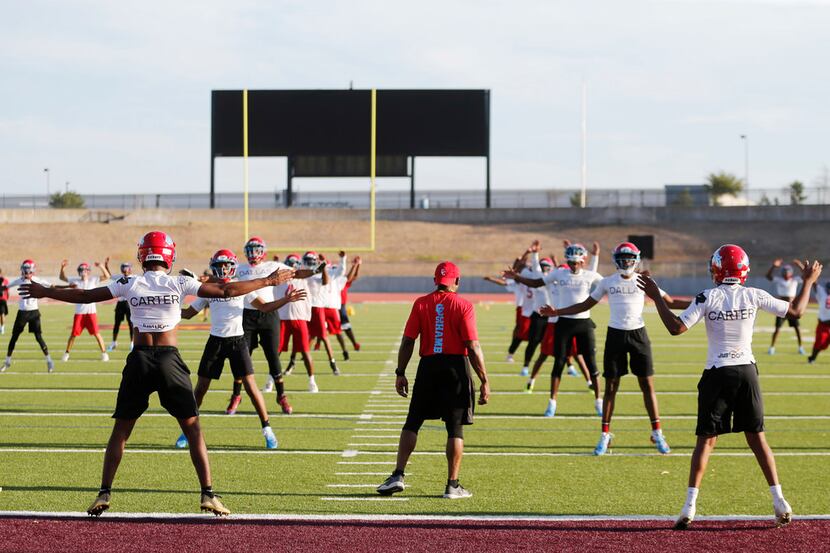The National Federation of State High School Associations — a U.S. leader in high school sports rules and regulations — released recommendations on Tuesday for how state governing bodies can approach “opening up” athletics and activities during the COVID-19 coronavirus pandemic.
NFHS published an 11-page document just before the UIL confirmed Tuesday it’s working with Texas state officials on a plan to allow limited in-person summer strength and conditioning starting June 8.
The guidelines — which cover three phases and designate risk levels for participants and sports — offer a glimpse of marked changes in high school sports operations as the pandemic continues to upend global health and economics.
Phase 1
NFHS recommends all coaches and students be screened for signs and symptoms of COVID-19 and to have their temperatures taken before a workout. Vulnerable individuals — defined by the CDC as people age 65 years or older and others with serious underlying health conditions — are to not oversee or participate.
Workouts should be limited to no more than 10 people, indoors or outdoors. Locker rooms and showers should be closed. Workouts should be conducted in “pods” of the same five to 10 students each time to ensure limited exposure if someone becomes infected.
All individuals should maintain six feet between one another at all times. Equipment should be wiped down regularly and hand sanitizer should be readily available. There should be no shared equipment and no spotting for weight lifting.
NFHS provided examples of how the Phase 1 guidelines would affect logistics for specific sports:
In football, teams should prohibit drills that include passing a single ball among participants, contact and use of tackling dummies, donuts or sleds. In volleyball and basketball, players should not use a single ball that others touch.
Phase 2
NFHS suggests relying on the same pre-workout screenings and to continue prohibiting vulnerable individuals from participating.
Workouts should not exceed 10 people indoors or 50 people outdoors. Meeting and locker rooms can open if all individuals can maintain six feet of distance. The same sanitizing protocols and small workout “pod” structures from Phase 1 are recommended, too.
NFHS suggests returning to practices and games for “lower risk” sports in Phase 2, which include activities performed at an acceptable distance and without shared equipment, such as individual track and field events, golf and swimming.
Moderate-risk sports — ones with protective equipment in place that would reduce the likelihood of spreading respiratory particles during close, sustained contact or ones that are lesser in contact — can also resume modified practices.
NFHS includes basketball, soccer, volleyball and 7-on-7 football in that category.
Phase 3
Any individuals with fever or cold symptoms in the previous 24 hours should not be allowed to participate in workouts. Vulnerable individuals can resume at a proper distance.
Gatherings can include up to 50 people indoors or outdoors. When participants are not playing, they should maintain three to six feet from others.
Moderate-risk sports can resume full practices and games with equipment either cleaned between each use or worn by only one individual.
Modified practices can begin for higher-risk sports, those with close, sustained contact and a higher probability of spreading respiratory particles. The category includes football, wrestling and boys lacrosse.
Aside from its three-phase guidelines for “opening up” high school sports, NFHS also highlights potential changes for transportation and accommodations.
Distancing guidelines may require schools to purchase more buses or vans to transport players to away games. The organization suggests limiting travel when possible to reduce time in vehicles and to avoid scheduling conflicts if states and areas resume play at different paces.
NFHS recommends allowing just essential personnel (athletes, coaches, officials, medical and event staff, and security) and preferred personnel (media) at events until state and local health departments lift restrictions on mass gatherings.
The organization also recommends all participants continue to wear cloth face coverings in states where masks are still part of public guidelines. Students, coaches, officials and contest personnel can also wear cloth face coverings, if preferred, during games.
NFHS included no clear guidelines on testing protocol and recommended states develop policies to account for periodic or in-season stoppages given the “near certainty of recurrent outbreaks this coming fall and winter in some locales.”
“Until a cure, vaccine or very effective treatment is readily available, or so-called ‘herd immunity’ is confidently reached” NFHS said in its release, “social distancing and other preventive measures such as face covering will be a ‘new normal’ if workouts, practices and contests are to continue.”
More from The News
Find more high school sports stories from The Dallas Morning News here.
To view subscription options for The News and SportsDay, click here.

